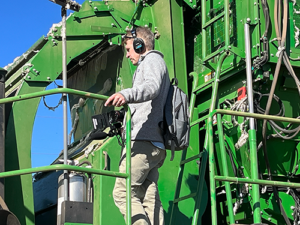Jayci Bishop Talks TALL
Jayci Bishop, director of Corporate Communications for Plains Cotton Cooperative Association (PCCA), is a member of the 18th cohort of the Texas Agricultural Lifetime Leadership (TALL) Program. The first session for this cohort was in July and second session was last week in West Texas. The following is the discussion we had concerning her experiences thus far.
Q: What made you interested in the TALL program?
A: Ever since I was in college, I heard people discussing TALL. When I came to work at PCCA, my original boss, John Johnson, was in the very first TALL class. It was always in the back of my mind, so when I had the opportunity to participate this year, I took it.
Q: What did you enjoy about the West Texas session? It must be a different perspective than most since you live and work here.
A: What I really enjoyed was getting to see my fellow students learn about this part of the country that I love so much. We did focus on the cotton industry, which I also love and work in, and it was special for me to see the TALL students meet some of the people I work with every day. It was good for me to see them interested and impressed with what we do here in West Texas — I may be biased, but I think what we do here is exceptional. I think it was eye-opening for them to see the logistics of cotton outside of growing it. From the warehouse to the classing office, they saw some interesting things outside of their normal scope of expertise.
Q: What do you believe was unique about this session?
A: Both here in Lubbock and in Amarillo, many TALL alumni were involved in the session. They were part of the program, they traveled with us, they were there every step of the way throughout the week. Then, of course, at the TALL alumni and student reception, we had a huge turnout. I had not yet seen that kind of alumni support at a TALL session. They all still had their TALL name tags — even some from the first class were proud to show them to us!
CNBC TV Visits Cotton Country
After spending more than 20 years overseas in more than 40 countries as a war photographer, Shawn Baldwin moved back to the U.S. to live a more domesticated life.
“I couldn’t go live in London or the Middle East for a year with a three-month old and a three-year-old at home. I was ready to settle down and concentrate on my family.”
It’s hard to imagine how an award-winning videographer, who covered the end of the apartheid in South Africa, could be in West Texas shooting a cotton story. But that’s exactly where he was this week.
Baldwin interviewed Kody Bessent, PCG CEO, Barry Evans, producer in Swisher County, and Craig Bednarz, West Texas A&M University associate professor. He also rode in a cotton stripper with Heath Heinrich to learn more about the cotton industry and why we love what we do here.
The 15-minute segment on the cotton industry is tentatively scheduled to air Nov. 24, 2022.
2022 Cotton Quality Summary
The following is a summary of the cotton classed at the Lubbock and Lamesa USDA Cotton Division Cotton Classing Offices for the 2021 production season.
- Avg. Daily Receipts
- Avg. Daily Classed
- Carryover (Bales)
- % Classed (Estimated)
- Bales
- Color (%)
- Leaf
- Staple
- Mike
- Strength
- Uniformity
- Bark (%)
Lamesa: 405
Lubbock: 7,170
Lamesa: 349
Lubbock: 6,570
Lamesa: 680
Lubbock: 4,640
Lamesa: 2.1
Lubbock: 4.6
Lamesa: 1,746
Lubbock: 32,831
Lamesa:
21+ – 38.5
31 – 49.9
12 – 0.0
Lubbock:
21+ – 71.3
31 – 10.6
12 – 7.5
Lamesa: 2.55
Lubbock: 2.4
Lamesa: 36.49
Lubbock: 36.79
Lamesa: 4.23
Lubbock: 4.18
Lamesa: 31.31
Lubbock: 31.40
Lamesa: 80.11
Lubbock: 80.76
Lamesa: 13.5
Lubbock: 6.8
Season Totals to Date
Lamesa: 3,910
Lubbock: 48,004
Lamesa:
21+ – 67.6
31 – 27
12 – 0.0
Lubbock:
21+ – 66.9
31 – 8.4
12 – 12.2
Lamesa: 2.51
Lubbock: 2.45
Lamesa: 36.2
Lubbock: 36.62
Lamesa: 4.36
Lubbock: 4.20
Lamesa: 31.64
Lubbock: 31.50
Lamesa: 80.47
Lubbock: 80.73
Lamesa: 12.6
Lubbock: 9.9
Slow, Long-Term Climb Ahead for Cotton Prices
It is always the darkest before the dawn. Old crop cotton futures are working overtime to establish the 77-78 cent area as the price bottom.
This week’s trading pushed prices down to an 18-month low as technical fund traders dumped volume after volume of sell orders every day. They pushed prices down for seven consecutive days before letting the market come up for air.
The difficult times remain front and center for the cotton grower, but bearish news is filtering out and explaining some of the current week’s activity. Textile mills, both in the U.S. and overseas, made announcements of temporary shutdowns between now and the Christmas holidays. Some mills will close for only a week and others will shut down for as much as a month. Still others will go to short work weeks. Either way, mills plan to reduce inventory of yarn stocks which has simply become far too burdensome. Should the lows established this week fail to hold, then the next line of price support is down another two cents, sitting at 74-75 cents.
Yet, demand is showing signs of turning, ever so slightly. The market began to uncover demand once it fell within the 79-81 cent trading range as indicated by the weekly export sales report. The very slight increase in export sales (and to be sure, the increase was slight) did find mills making overnight inquiries for cotton. Even inquiries that do not result in sales are positive given the present demand situation.
Read the entire article by O.A. Cleveland, which originally appeared in Cotton Grower.